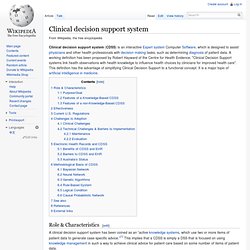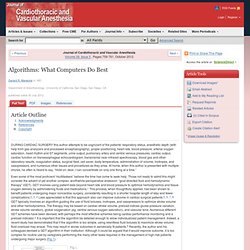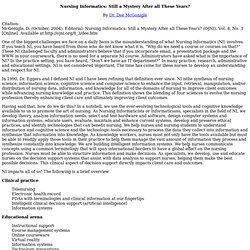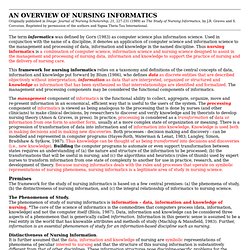

The Future of High-Tech Health Care. Demos, talks and a paper-plate dinner buffet were the fare last Friday evening at the Computer Museum in Mountain View, Calif., and the subject was the high-tech future of health care.

The gathering was hosted by FutureMed, a health-care program that is part of Singularity University, a networked organization dedicated to exploring how disruptive technologies can sweep across whole industries and society. The technologies on display were impressive, often inspiring — like the wearable-robots, or mechanical exoskeletons, made by Ekso Bionics, to enable people with spinal cord injuries to walk again; or I.B.M.’s Watson question-answering computer that is being morphed into a doctors’ smart assistant. Dr. 3D Medical Visualization & Information Systems. Causality in reasoning. Causality: Models, Reasoning and Inference (9780521895606): Judea Pearl. Using Big Data Analytics to Discover What Works in Healthcare.
GE healthymagination. Clinical decision support system. Role & Characteristics[edit] A clinical decision support system has been coined as an “active knowledge systems, which use two or more items of patient data to generate case-specific advice.”[1] This implies that a CDSS is simply a DSS that is focused on using knowledge management in such a way to achieve clinical advice for patient care based on some number of items of patient data.

Purpose/Goal[edit] There are two main types of CDSS:[2] Knowledge-BasedNonKnowledge-Based An example of how a CDSS might be used by a clinician comes from the subset of CDSS (Clinical Decision Support System), DDSS (Diagnosis Decision Support Systems). Another important classification of a CDSS is based on the timing of its use. Algorithms: What Computers Do Best. Published online 30 July 2012.

Article Outline DURING CARDIAC SURGERY this author attempts to be cognizant of the patients' respiratory status, anesthetic depth (with help from gas analyzers and processed encephalography), proper positioning, heart rate, blood pressure, arterial oxygen saturation, heart rhythm and ST segments, urine output, pulmonary artery and central venous pressures, cardiac output, cardiac function on transesophageal echocardiogram, transcranial near-infrared spectroscopy, blood gas and other laboratory results, coagulation status, surgical field, cell saver, body temperature, administration of volume, inotropes, and vasopressors, and numerous other issues and procedures as they arise.
At home, when this author is presented with multiple chores, he often is heard to say, “Hold on, dear, I can concentrate on only one thing at a time.” There are numerous reasons GDT has not been adopted universally, particularly in cardiac operating rooms. Graphical Arterial Blood Gas Visualization Tool Supports Rap... : Computers Informatics Nursing. A visualization tool that integrates numeric information from an arterial blood gas report with novel graphics was designed for the purpose of promoting rapid and accurate interpretation of acid-base data.

A study compared data interpretation performance when arterial blood gas results were presented in a traditional numerical list versus the graphical visualization tool. Critical-care nurses (n = 15) and nursing students (n = 15) were significantly more accurate identifying acid-base states and assessing trends in acid-base data when using the graphical visualization tool. Critical-care nurses and nursing students using traditional numerical data had an average accuracy of 69% and 74%, respectively. Current Issue : Computers Informatics Nursing. Clinical reasoning: concept analysis. [J Adv Nurs. 2010. Nursing Informatics: Still a Mystery After all These Years? Nursing Informatics: Still a Mystery After all These Years?

By Dr. Dee McGonigle Citation: McGonigle, D. Decision Making in Nursing - Rebecca A. Patronis Jones, Sharon E. Beck. An Overview of Nursing Informatics. AN OVERVIEW OF NURSING INFORMATICS Originally published in Image: Journal of Nursing Scholarship, 21, 227-231 (1989) as The Study of Nursing Informatics, by J.R.

Graves and S. Corcoran. Reprinted by permission of the authors and Sigma Theta Tau International. The term informatics was defined by Gorn (1983) as computer science plus information science. 0003-ch0001-9781437727760.indd - 9781437727760.pdf. Untitled - Clinical reasoning- concept analysis.pdf. CLINICAL REASONING (is this just one part of the process - Clinical-Reasoning-Instructor-Resources.pdf.
Clinical Reasoning, Decisionmaking, and Action: Thinking Critically and Clinically - Patient Safety and Quality - NCBI Bookshelf. The Advisory Board Company - Search. Using Predictive Modeling to Make Better Decisions. By Russ Richmond, MD In an article posted earlier this year on this blog I argued that hospitals have traditionally done a sub-par job of leveraging what has now been dubbed “big data.”

Effectively mining and managing the ever rising oceans of data presents both a major challenge – and a significant opportunity – for hospitals. By doing a better of job connecting the dots of their big data assets, hospital management teams can start to develop the crucial insights that enable them to make the right and timely decisions that are vital to success today. And, better, timelier decisions lead to improved results and a higher level of quality patient care. That’s the good news. At its most basic, predictive modeling is the process by which data models are created and used to try to predict the probability of an outcome. So, why aren’t more hospitals using predictive modeling to support their decision making and strategic planning activities?
Hospitals Lack Consistent Data ‘Plumbing’ Clinical Decision Making of Nurses Working in Hospital Settings.